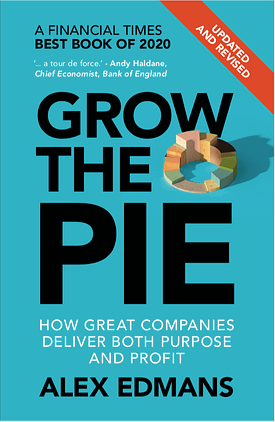Author: Alex Edmans, Professor of Finance, London Business School
Henry Ford is widely seen as one of the most innovative business leaders in history, often credited with the quote “If I had asked people what they wanted, they would have said faster horses”. But Ford didn’t actually invent the car. Instead, his greatest invention was using the assembly line to mass-produce it, making the car affordable to ordinary citizens.
Why was the assembly line so successful? Because it forced workers to keep up with the pace of production, squeezing as much effort out of workers as possible.
Indeed, extracting from employees has historically been viewed as the role of management. The value that a company creates is seen as a fixed pie. A CEO’s duty is to maximise profit – investors’ slice of the pie. If the pie is fixed, this requires her to reduce the slice taken by workers. So, she pays them rock bottom wages and works them to the bone. Employees are no different to any other resource – a manager would never overpay for raw materials or leave them unused.
While this might seem a caricature, many elements of this pie-splitting mentality stills remain prevalent today. Scandals at Sports Direct and BHS arose because these companies failed to pay the minimum wage or fund employee pensions. And this mentality prevails across different industries. When I was a junior investment banker, my Vice President once caught me laughing and told me I wasn’t allowed to laugh in the office. When I asked him why, he said that the Managing Director would think that he wasn’t a good boss as he wasn’t working me hard enough.
Such human resource practices are highly damaging. Not only to employees but, less obviously, to businesses themselves. The pie-growing mentality stresses that the pie is not fixed. By extracting as much as possible out of workers, a company doesn’t increase investors’ slice of the pie. Instead, it shrinks it, ultimately harming investors, because these workers become less motivated and productive. And on the flipside, investing employees grows the pie, boosting company performance in the long term. The idea that the pie can be expanded – that both employees and shareholders can simultaneously gain – might seem a too-good-to-be-true pipedream, so we need rigorous evidence to back it up.

That’s what I set out to do. In a book, “Grow the Pie: How Great Companies Deliver Both Purpose and Profit”, recently updated for the pandemic, I lay out the results of a study using 28 years of data, spanning a range of industries, on the effect of employee well-being on shareholder returns. Measuring employee well-being is tricky, because it’s a holistic concept that can’t be reduced to a simple number. Wages are important, but a company could pay high wages despite having scant attention to skills development – Ford paid his employees $5 a day, generous at the time. So, I used the list of the “Best Companies to Work For”, which randomly selects 250 employees and surveys them on 57 questions spanning credibility, respect, fairness, pride, and camaraderie.
To isolate the effect of employee well-being, I stripped out the impact of a company’s size, industry, recent performance, and other factors that may have driven returns. And I addressed the problem that it could be firm performance that causes employee well-being, rather than the other way round. After all that blood, sweat, and tears, what were the results? I found that the Best Companies to Work For beat their peers by 2.3-3.8% per year – 89-184% when compounded over those 28 years.
What does it mean for practitioners? The key implication is that growing-the-pie is not pie-in-the-sky: investing in workers works for investors. When I speak to companies on the importance of employee well-being, I’m introduced as a Professor of Finance and the audience often thinks they’ve misheard. The finance department is frequently the enemy of HR, believing that it’s a cost centre and a distraction from profits. But the results show that any finance department with this mindset is failing at its job.
Second, the Best Companies survey shows that it’s not simply about throwing money at workers. Also key are intangible factors, such as empowerment, opportunities to step up, and viewing them as a source of ideas rather than simply a means of executing them. Interestingly, my study was successfully replicated by independent researchers earlier this month, not only for the original time period of 1984-2011 but also for 2012-2020. This is surprising since, after a trading strategy is published, investors should pounce on it, causing the returns to go away. This should be particularly the case since investors are paying increasing attention to ESG issues. However, many investors may be focusing on quantitative measures, such as employee turnover and CEO-to-worker pay ratios. While these aren’t unimportant, most important dimensions of employee wellbeing are simply not captured in the numbers. They continue to be ignored by investors, and so the Best Companies have continued to outperform in the nine years since my study was published.
Finally, developing a company’s workforce is a CEO level issue, rather than one to be delegated solely to the HR department. A leading investor told me that she evaluates companies by asking CEOs about their people. Some can answer on the spot; others respond “I didn’t know you’d ask about my employees – next time I’ll bring the HR director along.”
CEOs often claim that “people are our greatest asset”, but as marketing spin rather than because they genuinely believe it. They think that acting on this claim would fritter away profits. But the evidence suggests that it’s true. Investing in your employees is not only moral and ethical. It’s good business sense.




